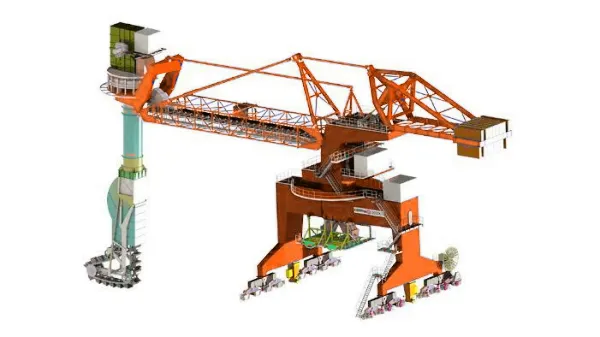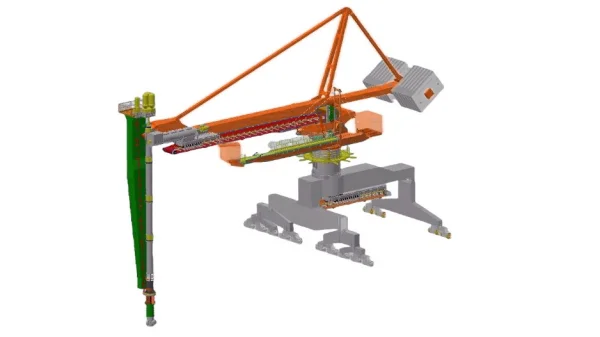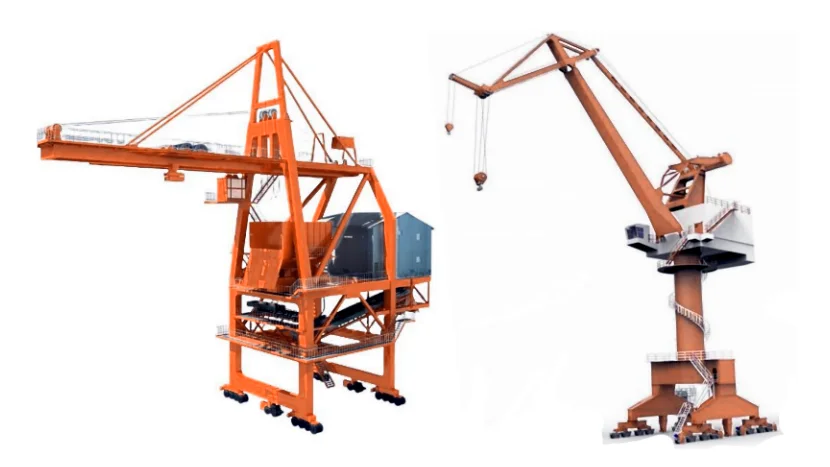Just let we know what you want, and we will get in touch with you as soon as possible!
Mobile Bulk Material Handling Experts
Advantages and Disadvantages of Screw Ship Unloaders
Screw ship unloaders are specialized machines used for unloading bulk materials, such as coal, grain, cement, or quicklime, from ships. They utilize a rotating screw (auger) mechanism to extract material from a ship's hold and transfer it to shore-based conveyors or storage systems. Given your focus on unloading coal and quicklime with mobile hoppers and stackers, screw unloaders are relevant for their ability to handle these materials efficiently, especially in enclosed systems suitable for dust control or closed-hatch operations. Below, I outline the advantages and disadvantages of screw ship unloaders in the context of port operations for bulk carriers.

Advantages of Screw Ship Unloaders
1. Enclosed Operation for Dust Control
Screw ship unloaders operate within sealed casings, which significantly minimizes dust emissions—a crucial advantage when handling dusty materials such as coal or quicklime. This enclosed design not only reduces environmental impact but also helps ports comply with strict regulatory limits, such as maintaining dust concentrations below 50 mg/m³. To further enhance performance, dust collectors such as baghouses can be integrated at transfer points. For example, when unloading quicklime from a Handymax vessel of around 50,000 DWT, a sealed screw system effectively prevents the release of caustic dust, protecting both workers and the surrounding environment while meeting closed-hatch operational requirements.
2. Continuous and Efficient Unloading
Screw ship unloaders provide steady, high-throughput operation, typically ranging from 300 to 2,000 t/h depending on the equipment size, which significantly reduces vessel turnaround times compared to intermittent grab cranes. This makes them particularly well-suited for high-volume vessels such as Panamax ships (around 70,000 DWT) or Capesize ships (up to 180,000 DWT), where fast and continuous unloading—such as at 1,000 t/h—is essential to maintain port efficiency. For instance, a screw unloader with a capacity of 1,200 t/h can discharge a 70,000-ton coal cargo in approximately 60 hours, including necessary repositioning within the holds.
3. Closed-Hatch Compatibility
Screw ship unloaders can interface with sealed hatch outlets or bottom discharge points through flexible hoses or custom adapters, making them ideal for closed-hatch unloading requirements such as those for quicklime. This configuration enables dust-free and moisture-protected material handling, which is critical for reactive materials like quicklime or combustible coal dust. For example, a screw unloader equipped with a sealed inlet can connect directly to a ship's bottom discharge valve, ensuring complete containment of the cargo throughout the unloading process.
4. Versatility Across Materials
Screw ship unloaders are capable of handling a wide range of bulk materials, including coal (0.8–1.2 t/m³), quicklime (1.0–1.6 t/m³), grain (0.6–0.8 t/m³), and cement, by adjusting screw design parameters such as pitch and diameter. This versatility makes them well-suited for ports handling diverse cargoes and vessel sizes, from Mini bulk carriers to large Capesize ships. For instance, a single screw unloader can switch between unloading coal and quicklime with only minor configuration changes, providing flexibility and operational efficiency in multi-commodity port environments.
5. Compact Footprint
Screw ship unloaders require less dock space than large grab cranes or continuous bucket unloaders, thanks to their compact screw mechanism and the option to be rail-mounted or mobile. This makes them particularly suitable for smaller ports or constrained berths handling vessels such as Handysize (around 30,000 DWT) or Supramax (around 55,000 DWT). For example, a rail-mounted screw unloader like the Bühler DSH can operate efficiently within narrow dock spaces while maintaining a capacity of around 500 t/h.
6. Low Material Degradation
The gentle handling action of screw ship unloaders significantly reduces particle breakage compared to grab cranes, helping to preserve the quality of materials such as coal or quicklime by minimizing the production of fines. This is particularly important in markets where coal size consistency affects combustion efficiency or where the reactivity of quicklime must be maintained for industrial processes. For example, when unloading coal granules sized 5–50 mm, a screw unloader can limit degradation to less than 5%, ensuring product quality is maintained from ship to storage.

Disadvantages of Screw Ship Unloaders
1. Limited Reach and Flexibility
Screw ship unloaders have a fixed or limited reach, typically with boom lengths in the range of 10–30 meters, which means they require precise positioning or even ship movement to access all cargo holds. This makes them less versatile than mobile grab cranes when working on large vessels such as Capesize ships (around 290 m LOA with 9 holds) or Chinamax ships (around 360 m LOA), where the holds span a wide area. To mitigate this limitation, ports can employ rail-mounted or slewing screw unloaders to increase reach, or deploy multiple units to service larger vessels efficiently.
2. Lower Throughput for Large Ships
Screw ship unloaders typically offer throughputs of 300–2,000 t/h, which is lower than the capacities of high-performance grab cranes or continuous bucket unloaders that can reach 3,000–5,000 t/h. This limitation can slow operations when handling massive cargo volumes. For example, unloading a Chinamax vessel carrying 350,000 tons of coal with a 1,500 t/h screw unloader would take roughly 233 hours, compared to about 70 hours with a 5,000 t/h bucket unloader. To address this, high-volume ports can deploy multiple screw unloaders in parallel or integrate them with other unloading systems to boost total capacity.
3. High Initial and Maintenance Costs
Screw ship unloaders are relatively expensive to purchase, with costs ranging from around $1–5 million for a 1,000 t/h unit, and they require ongoing maintenance due to the complexity of their screw mechanisms. Abrasive materials such as coal accelerate wear, often necessitating screw replacements every 1–3 years. This can lead to higher operating costs, particularly for ports with low throughput or seasonal operations where the equipment is underutilized. To mitigate these expenses, operators can use wear-resistant materials such as Hardox steel for screw construction and implement a strict preventive maintenance schedule to extend component life.
4. Material Bridging and Clogging
Screw ship unloaders can struggle with sticky or cohesive materials—such as wet coal or quicklime—that tend to bridge or clog the screw, disrupting material flow and often requiring downtime for cleaning. This issue can reduce effective throughput by 20–30% for challenging cargos like wet coal and increase labor and maintenance costs. To mitigate these problems, operators may install vibrators or air fluidizers to keep material moving smoothly, apply anti-stick coatings such as PTFE lining inside the screw, and, where feasible, pre-dry quicklime before unloading to reduce moisture content and improve flowability.
5. Energy Consumption
Screw ship unloaders require significant power—typically between 200 and 500 kW for a 1,000 t/h unit—because of the continuous rotation of the screw conveyor. This energy demand is often higher than that of pneumatic unloading systems for certain materials, leading to increased operational costs, especially in high-throughput operations. For example, running a 1,000 t/h screw unloader continuously over 24 hours can consume around 4,800 kWh per day. To mitigate these costs, operators can optimize screw rotation speeds to match material flow requirements and equip the system with energy-efficient motors, such as IE3-rated models, to improve overall power efficiency.
6. Complex Setup for Closed Hatches
While screw ship unloaders are compatible with closed-hatch operations, connecting them to sealed outlets—such as ship bottom discharge valves—often requires custom adapters or flexible hoses. This adds setup time and increases equipment costs. Such challenges may cause unloading delays, particularly when servicing vessels without standardized or uniform discharge points, common in older ships. To mitigate these issues, ports can use flexible hoses combined with universal couplings to accommodate varying ship designs and ensure smoother connections, as well as coordinate closely with ship operators to pre-plan equipment compatibility based on vessel specifications.

Screw ship unloaders are excellent for unloading coal or quicklime from bulk carriers, offering enclosed, continuous operation (ideal for closed hatches), high efficiency (300–2,000 t/h), and versatility across materials. However, they face challenges like limited reach, lower throughput for large ships, and maintenance costs for abrasive cargoes. They pair well with mobile hoppers (e.g., 50–100 m³) for dust-controlled transfer to stackers in ports handling Handysize to Panamax ships. For larger ships (Capesize/Chinamax), consider multiple units or alternatives like bucket unloaders.
If you have a specific ship type (e.g., 55,000 DWT Supramax), port setup, or material (coal vs. quicklime), let me know, and I'll tailor the analysis further!

 English
English



